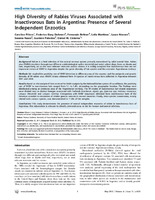Por favor, use este identificador para citar o enlazar este ítem:
http://sgc.anlis.gob.ar/handle/123456789/405| Title: | High diversity of rabies viruses associated with insectivorous bats in Argentina: presence of several independent enzootics | Authors: | Piñero, Carolina Gury Dohmen, Federico Beltran, Fernando Martinez, Leila Novaro, Laura Russo, Susana Palacios, Gustavo Cisterna, Daniel |
Keywords: | Virus de la Rabia;Quirópteros;Argentina;Serotipificación;Filogeografía;Epidemiología Molecular;Análisis por Conglomerados | Issue Date: | 2012 | Description: | BACKGROUND Rabies is a fatal infection of the central nervous system primarily transmitted by rabid animal bites. Rabies virus (RABV) circulates through two different epidemiological cycles: terrestrial and aerial, where dogs, foxes or skunks and bats, respectively, act as the most relevant reservoirs and/or vectors. It is widely accepted that insectivorous bats are not important vectors of RABV in Argentina despite the great diversity of bat species and the extensive Argentinean territory. METHODS We studied the positivity rate of RABV detection in different areas of the country, and the antigenic and genetic diversity of 99 rabies virus (RABV) strains obtained from 14 species of insectivorous bats collected in Argentina between 1991 and 2008. RESULTS Based on the analysis of bats received for RABV analysis by the National Rabies system of surveillance, the positivity rate of RABV in insectivorous bats ranged from 3.1 to 5.4%, depending on the geographic location. The findings were distributed among an extensive area of the Argentinean territory. The 99 strains of insectivorous bat-related sequences were divided into six distinct lineages associated with Tadarida brasiliensis, Myotis spp, Eptesicus spp, Histiotus montanus, Lasiurus blosseviilli and Lasiurus cinereus. Comparison with RABV sequences obtained from insectivorous bats of the Americas revealed co-circulation of similar genetic variants in several countries. Finally, inter-species transmission, mostly related with Lasiurus species, was demonstrated in 11.8% of the samples. CONCLUSIONS This study demonstrates the presence of several independent enzootics of rabies in insectivorous bats of Argentina. This information is relevant to identify potential areas at risk for human and animal infection. Fil: Piñero, Carolina. ANLIS Dr.C.G.Malbrán. Instituto Nacional de Enfermedades Infecciosas. Servicio de Neurovirosis; Argentina. Fil: Gury Dohmen, Federico. Instituto de Zoonosis Dr. Luis Pasteur; Argentina. Fil: Beltran, Fernando. Instituto de Zoonosis Dr. Luis Pasteur; Argentina. Fil: Martinez, Leila. ANLIS Dr.C.G.Malbrán. Instituto Nacional de Enfermedades Infecciosas. Servicio de Neurovirosis; Argentina. Fil: Novaro, Laura. Servicio Nacional de Sanidad y Calidad Agroalimentaria. Dirección de Laboratorio y Control Técnico; Argentina. Fil: Russo, Susana. Servicio Nacional de Sanidad y Calidad Agroalimentaria. Dirección de Laboratorio y Control Técnico; Argentina. Fil: Palacios, Gustavo. George Mason University. National Center for Biodefense and Infectious Diseases; Estados Unidos. Fil: Cisterna, Daniel. ANLIS Dr.C.G.Malbrán. Instituto Nacional de Enfermedades Infecciosas. Servicio de Neurovirosis; Argentina. |
URI: | http://sgc.anlis.gob.ar/handle/123456789/405 http://www.plosntds.org/article/info%3Adoi%2F10.1371%2Fjournal.pntd.0001635 |
ISSN: | 1935-2735 | Rights: | info:eu-repo/semantics/openAccess |
| Appears in Collections: | snrd Publicaciones INEI |
Files in This Item:
| File | Description | Size | Format | |
|---|---|---|---|---|
| PLoSNeglectedTropicalDiseases,2012,6(5),e1635..pdf | 775.19 kB | Adobe PDF |  View/Open |
Page view(s)
167
checked on Dec 14, 2025
Download(s)
78
checked on Dec 14, 2025
Google ScholarTM
Check
Items in DSpace are protected by copyright, with all rights reserved, unless otherwise indicated.

